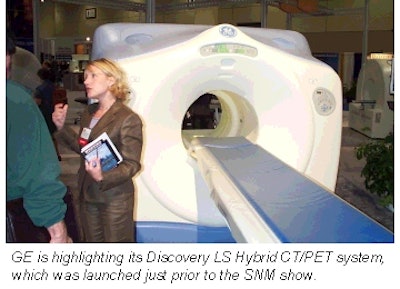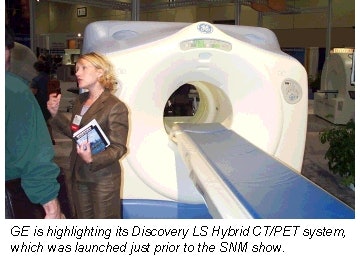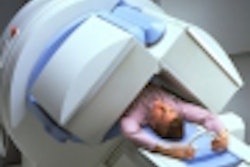
GE Medical Systems believes that fusion imaging is the future of nuclear medicine. And the Waukesha, WI-based firm is backing up its vision with the launch of a family of combo scanners at this week's Society of Nuclear Medicine meeting.
The company's flagship fused imaging scanner is Discovery LS, which was formally introduced on Thursday during a media event in New York City. Originally showcased to the radiology community as a work-in-progress at last year's RSNA meeting, Discovery LS features GE's premium Advance NXi PET system combined with the vendor's multislice LightSpeed Plus CT scanner.
Discovery LS has been installed at three beta sites: University Hospital in Zurich, Switzerland; Johns Hopkins Medical Institutions in Baltimore; and Rambam Medical Center. GE has high hopes for Discovery LS, expecting shipments to total more than 30 by the end of this year. The unit will cost approximately $2.7 million.
As it builds its fusion imaging line, GE is making use of technology acquired from its purchase of SMV last year. Discovery VI, being shown as a work-in-progress, incorporates the six-detector design of SMV's Positrace hybrid CT/PET scanner.
 |
GE has added performance enhancements, however, such as new one-inch sodium iodide detector crystals, called Starbright. In addition, the company has also married the PET system with GE's HiSpeed CT scanner, and incorporated 3:1 electronics to speed acquisition times. Discovery VI, which is expected to begin shipping in the fourth quarter, will carry a price tag of around $1.3 million.
"This is going to be a great alternative for customers who want to get into PET/CT," according to Beth Klein, vice president and general manager of global functional imaging.
GE is also highlighting Discovery VH, a multipurpose PET/SPECT/CT system that builds on the company's successful Hawkeye module released at least year's SNM show. Starbright crystals have been added on both detectors, producing a 50% improvement in PET lesion detection, Klein said. The thicker crystal dramatically increases the imaging efficiency for higher energies, especially for PET studies, according to the company.
"With Hawkeye together with the one-inch crystal, physicians are regularly seeing lesions in the 1-cm range, and sometimes even smaller than that," Klein said.
GE said that Discovery VH can also be used as a conventional SPECT or planar nuclear medicine camera for low-energy applications.
The company is also seeking to expand on the success of last year's introduction of Hawkeye, which has been installed at 75 centers and scanned approximately 5,000 patients since its introduction at last year's SNM meeting. Users now can select GE’s CT attenuation correction software for enhanced image quality, or functional anatomic mapping software that improves localization of pathological findings, according to the firm.
GE will also be rolling out a Hawkeye version for nuclear cardiology, featuring SPECT and the use of CT for attenuation correction for cardiology studies. That system will cost under $500,000.
"What we've done is take the clinical results from Hawkeye and migrated that up into dedicated PET, and also migrated it down into nuclear cardiology," Klein said.
In other SNM introductions, GE will debut new software applications for its eNtegra and PowerStation workstations, with an emphasis on connectivity and workflow improvements. Both eNtegra and PowerStation are now available on the same platform, she said.
"We've made both workstations fully compatible with both the GE and SMV installed base," Klein said. "A customer now has the ability to mix and match their nuclear medicine systems together with the workstation of their choice."
On eNtegra, clients can also choose from options such as an inbox that allows for batch access and allocation of patient studies directly to physicians for review, both locally and remotely. GE has also migrated the MyoSPECT cardiac analysis package from PowerStation (acquired from SMV) to eNtegra. Other eNtegra options include: a neurology suite, Cedars BPGS analysis of gated blood pool SPECT, and automatic motion correction.
New options on PowerStation include the Cedars suite of cardiac analysis packages and a cerebral analysis package. GE has also enhanced PET DICOM compliance and improved integration with PACS networks, according to the firm.
GE will also show a work-in-progress extension of eNtegra to a pocket PC environment, allowing physicians to gain access to images, scheduling, and workflow from anywhere, Klein said.
By Erik L. RidleyAuntMinnie.com staff writer
June 25, 2001
Related Reading
GE unveils Discovery LS hybrid CT/PET system, June 22, 2001
FDA clears GE combo PET/CT scanner, April 16, 2001
GE and Siemens cross swords in hybrid PET/CT imaging, November 28, 2000
Click here to post your comments about this story. Please include the headline of the article in your message.
Copyright © 2001 AuntMinnie.com





















